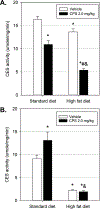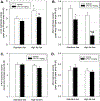Inhibition of cholinergic and non-cholinergic targets following subacute exposure to chlorpyrifos in normal and high fat fed male C57BL/6J mice
- PMID: 29935250
- PMCID: PMC6534279
- DOI: 10.1016/j.fct.2018.06.051
Inhibition of cholinergic and non-cholinergic targets following subacute exposure to chlorpyrifos in normal and high fat fed male C57BL/6J mice
Abstract
The effects of obesity on organophosphate pesticide-mediated toxicities, including both cholinergic and non-cholinergic targets, have not been fully elucidated. Therefore, the present study was designed to determine if high fat diet intake alters the effects of repeated exposure to chlorpyrifos (CPS) on the activities of both cholinergic and noncholinergic serine hydrolase targets. Male C57BL/6J mice were placed on either standard rodent chow or high fat diet for four weeks with CPS exposure (2.0 mg/kg) for the last 10 days of diet intake. Exposure to CPS did not alter acetylcholinesterase in the central nervous system, but it did significantly inhibit circulating cholinesterase activities in both diet groups. CPS significantly inhibited hepatic carboxylesterase and fatty acid amide hydrolase and this inhibition was significantly greater in high fat fed animals. Additionally, CPS exposure and high fat diet intake downregulated genes involved in hepatic de novo lipogenesis as well as cytochrome P450 enzymes involved in hepatic xenobiotic metabolism. In summary, the present study demonstrates that high fat diet intake potentiates CPS mediated inhibition of both carboxylesterase and fatty acid amide hydrolase in the liver of obese animals following subacute exposure and suggests obesity may be a risk factor for increased non-cholinergic hepatic CPS toxicity.
Keywords: Acetylcholinesterase; Carboxylesterase; Chlorpyrifos; Endocannabinoid; High fat diet; Organophosphate.
Copyright © 2018 Elsevier Ltd. All rights reserved.
Conflict of interest statement
Conflicts of interest
None of the authors have any conflicts of interest with the present study.
Figures





Similar articles
-
Effects of acute exposure to chlorpyrifos on cholinergic and non-cholinergic targets in normal and high-fat fed male C57BL/6J mice.Toxicol Appl Pharmacol. 2017 Dec 15;337:67-75. doi: 10.1016/j.taap.2017.10.019. Epub 2017 Oct 31. Toxicol Appl Pharmacol. 2017. PMID: 29097212
-
Effect of high fat diet on the toxicokinetics and toxicodynamics of chlorpyrifos following acute exposure in male C57BL/6J mice.J Biochem Mol Toxicol. 2022 Jun;36(6):e23028. doi: 10.1002/jbt.23028. Epub 2022 Feb 28. J Biochem Mol Toxicol. 2022. PMID: 35225412
-
Effects of chlorpyrifos on non-cholinergic toxicity endpoints in immortalized and primary rat hepatocytes under normal and hepatosteatotic conditions.Toxicol In Vitro. 2022 Apr;80:105329. doi: 10.1016/j.tiv.2022.105329. Epub 2022 Feb 11. Toxicol In Vitro. 2022. PMID: 35151815 Free PMC article.
-
Determination of the reference dose for chlorpyrifos: proceedings of an expert panel.J Toxicol Environ Health B Crit Rev. 1999 Jul-Sep;2(3):211-55. doi: 10.1080/109374099281179. J Toxicol Environ Health B Crit Rev. 1999. PMID: 10429680 Review.
-
Developmental cholinotoxicants: nicotine and chlorpyrifos.Environ Health Perspect. 1999 Feb;107 Suppl 1(Suppl 1):71-80. doi: 10.1289/ehp.99107s171. Environ Health Perspect. 1999. PMID: 10229709 Free PMC article. Review.
Cited by
-
Effects of Lactobacillus plantarum FZU3013-Fermented Laminaria japonica on Lipid Metabolism and Gut Microbiota in Hyperlipidaemic Rats.Front Nutr. 2021 Dec 6;8:786571. doi: 10.3389/fnut.2021.786571. eCollection 2021. Front Nutr. 2021. PMID: 34938762 Free PMC article.
-
Programming of intestinal homeostasis in male rat offspring after maternal exposure to chlorpyrifos and/or to a high fat diet.Sci Rep. 2021 Jun 1;11(1):11420. doi: 10.1038/s41598-021-90981-2. Sci Rep. 2021. PMID: 34075131 Free PMC article.
-
Cnr1-/- has minimal impact on chlorpyrifos-mediated effects in the mouse endocannabinoid system, but it does alter lipopolysaccharide-induced cytokine levels in splenocytes.Chem Biol Interact. 2023 Apr 25;375:110425. doi: 10.1016/j.cbi.2023.110425. Epub 2023 Feb 27. Chem Biol Interact. 2023. PMID: 36858108 Free PMC article.
-
Oxidative Stress in NAFLD: Role of Nutrients and Food Contaminants.Biomolecules. 2020 Dec 21;10(12):1702. doi: 10.3390/biom10121702. Biomolecules. 2020. PMID: 33371482 Free PMC article. Review.
-
Concentration-dependent effects of chlorpyrifos oxon on peroxisome proliferator-activated receptor signaling in MCF-7 cells.Toxicol In Vitro. 2022 Feb;78:105268. doi: 10.1016/j.tiv.2021.105268. Epub 2021 Oct 29. Toxicol In Vitro. 2022. PMID: 34756920 Free PMC article.
References
-
- Acker CI, Nogueira CW, 2012. Chlorpyrifos acute exposure induces hyperglycemia and hyperlipidemia in rats. Chemosphere 89, 602–608. - PubMed
-
- Ahdaya S, Guthrie FE, 1981. Stomach absorption of intubated insecticides in fasted mice. Toxicology 22, 311–317. - PubMed
-
- Bahitham W, Watts R, Nelson R, Lian J, Lehner R, 2016. Liver-specific expression of carboxylesterase 1g/esterase-x reduces hepatic steatosis, counteracts dyslipidemia and improves insulin signaling. Biochim. Biophys. Acta 1861, 482–490. - PubMed
MeSH terms
Substances
Grants and funding
LinkOut - more resources
Full Text Sources
Other Literature Sources

